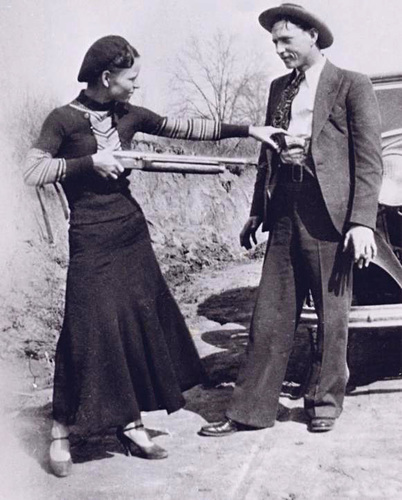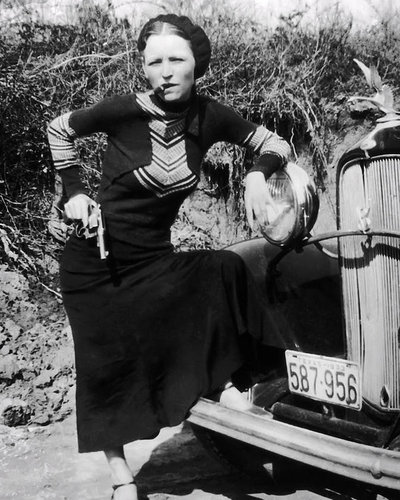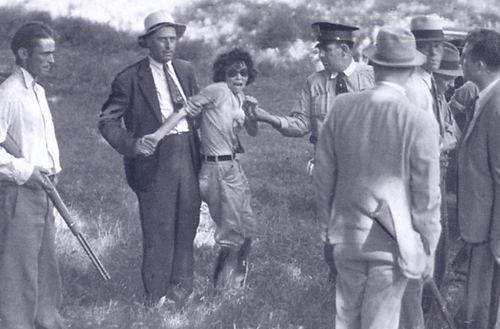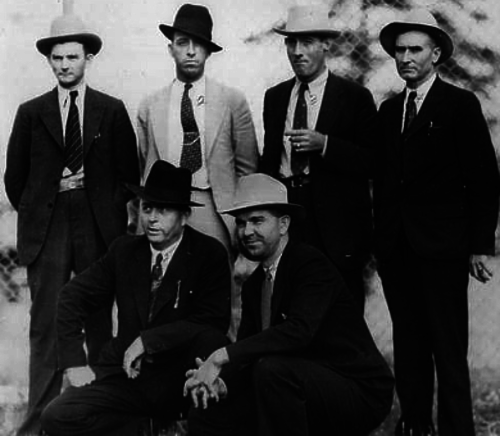Noiser
Outlaws In Love: The Tale of Bonnie and Clyde
Play Short History Of... Bonnie and Clyde
In 1932, Bonnie and Clyde were known as America’s most famous outlaws. By 1934, they were both dead. So why do we remember their short reign of terror almost a century later?

The Makings of Outlaws
Clyde Barrow was born in Dallas, Texas in March 1909. Growing up in poverty, Clyde soon turned to crime to escape his family's financial struggles. At first, under the tutelage of his big brother Buck, Clyde stole a rooster to enter into a cockfighting match. He then progressed to stealing cars, putting him on a collision course with the law.
Bonnie Parker, born on October 1st, 1910, was also a Texas native. In January 1930, Bonnie met Clyde in the kitchen of a friend’s house. It was love at first sight, but the whirlwind romance was short-lived. In the following weeks, Clyde was convicted of auto theft and sent to jail.
After a difficult two years, Clyde was released from Eastham Prison in January 1932. As he walked through the outer gate a free man, he made two promises to himself.
One - he would never again set foot in prison.
Two - he vowed revenge on the system that tried to break him.
A Downward Spiral
It didn’t take Clyde long to reprise his criminal undertakings. In the days following his release, he started robbing gas stations and town stores with his gang, often for little reward. At one of these robberies, a store owner was killed.
Things took an even darker turn soon after. One night, a sheriff and his deputy approached Clyde and his buddies. Without warning, Clyde opened fire, killing one of the lawmen and seriously wounding the other. It wasn’t his first murder, but it was the first time he’d killed a law enforcement officer. A line had been crossed.

The Barrow Gang, comprised of Clyde, Bonnie, and a sixteen-year-old known as J.D., travelled America in stolen cars, stealing what they wanted and renting rooms when they needed to lie low. Lawmen were constantly on their case, but the Barrow Gang had too much firepower for the cops. A shoot-out in Missouri on April 13th, 1932 left two officers dead. But, when the gang fled, they made their first catastrophic mistake – they left behind personal belongings. Among them were Bonnie’s notebooks and camera. By morning, sensational pictures of the Barrow Gang had been splashed over front pages across the country.
The police and news outlets intended to shock the public by releasing pictures of the gang brandishing firearms in front of stolen cars, but they had the opposite effect. The depression-weary public began to see Bonnie and Clyde as anti-heroes, sticking it to the banks and institutions that they blamed for their own hardships.
The Law Closes In
But not everyone was so enamoured with the expanding Barrow Gang.
At 5 am on July 24th, 1933, Clyde, Bonnie, J.D., Buck (Clyde’s brother) and his wife, Blanche, were hiding out in an abandoned amusement park in Dexter, Iowa. A couple of months earlier, a car battery had exploded, dousing Bonnie’s leg with corrosive acid. With the love of his life in constant pain, Clyde had redoubled his efforts, robbing constantly to fund the medicine she needed. But the law had finally caught up with them.

Bonnie, Clyde and the rest of the Barrow gang were eating breakfast when a shout came from the surrounding trees. Unbeknownst to the gang, the sheriff had rounded up a posse and hunted them down. Clyde tried to get the jump, firing his rifle into the shrubbery. A maelstrom of bullets came in reply, hitting Clyde in the arm and Buck in the back. Clyde, Bonnie, and J.D. made a run for it, leaving Buck and Blanche behind. Buck would die from his injuries in the days that followed; Blanche would soon be behind bars. Amazingly, the rest of the Barrow Gang escaped.
In response, Ranger Frank Hamer was called on. Hamer was an infamous manhunter with dubious morals and a reputation for bringing down his quarry by any means necessary. The end was nigh for Bonnie and Clyde.
The End of the Road
At 9 am on Wednesday, 23rd May 1934, Clyde sped along a section of Highway 154 in Louisiana in his stolen Ford. He slowed when he saw a friend's truck at the side of the road, with a wheel missing. What he didn't know was that it was a set-up.
Frank Hamer and his five chosen men were hidden in bushes on the other side of the road. When Clyde got out of the car, gunshots rang out. Clyde slumped on the road, dead. Bonnie, in the passenger seat, was hit too. It was estimated later that the six men fired over 150 rounds into the car, killing the outlaws instantly. Clyde was twenty-four years old; Bonnie was just twenty-three.
 Bonnie and Clyde are often fondly remembered as outlaws in an era of government oppression and extreme poverty. It’s true they lived by their own rules and forged their own destinies in an era when escaping your lot in life was extremely difficult. But Bonnie and Clyde were also cold-blooded killers who never hesitated to pull the trigger. In the wake of their lawlessness, they left countless widows, orphans and heartbroken families. Is their legendary reputation warranted?
Bonnie and Clyde are often fondly remembered as outlaws in an era of government oppression and extreme poverty. It’s true they lived by their own rules and forged their own destinies in an era when escaping your lot in life was extremely difficult. But Bonnie and Clyde were also cold-blooded killers who never hesitated to pull the trigger. In the wake of their lawlessness, they left countless widows, orphans and heartbroken families. Is their legendary reputation warranted?

Bonnie and Clyde, in the end, were relatively unsuccessful bank robbers and regional celebrities who have grown into this gruesome touchstone of American culture. I think their enduring appeal obviously stems from their real love for each other, from their sort of Romeo and Juliet, could go down together. It's a strange thing, their mythical role in culture.
Paul Schneider, journalist and author of Bonnie and Clyde – The Lives Behind The Legend.
